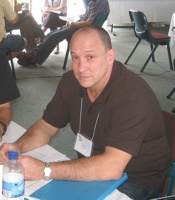10 questions for Gary Hourigan

Recently caught up with Gary Hourigan at the next1000 Summit. Gary's learning about church planting movements by doing it. So he seemed a good candidate for 10 Questions. . .
1. What's your background?
Back in 1983 my wife Terri and I were feeling the pressures of life. She met an old friend who invited her to church at Garden City AOG. She attended for a month and then tricked me into meeting one of the pastors. I wanted to kick him out of my house. He kept building the relationship and eventually I came to faith.
At the time I was in the banking industry and soon after coming to faith was appointed as a Bank Manager. A few years later I accepted the challenge of opening a new branch of the bank in Noosa Heads on the south Queensland coast, which was strategically designed to be a sound career move. Success would mean even greater opportunity for advancement.
God had other plans. We got involved in a recently planted Christian Outreach Centre Church (COC) which was growing rapidly. Our church involvement soon became the centre of our world, rather that the career. After a few more years experiencing success in the bank, God called us into ministry.
Eventually we were appointed senior ministers of the church. The church grew to about 1000 people, which brought both joy and great challenges in leadership.
I discovered Natural Church Development (NCD) and began applying a health paradigm to life of the church.
Soon after our denomination appointed a new national chairman, David McDonald, with the specific agenda to lead us back into being a dynamic church planting movement. David recruited me to work with him.
Since 2001 my job description has been to understand and implement church multiplication strategies within the COC nationally.
2. What motivates you?
Two things: Firstly, I'm motivated by the harvest. The Church in Western world is not growing. When measured against it's mission it is not being effective.
Secondly, I have a great heart for the well being of pastors. I see many of them working at programs and systems and models of church that aren't fruitful. Hope deferred makes the heart sick. We'll losing too many of them from the ministry.
3. What's your strategy?
We've adopted Bob Logan's 10 points of multiplication. I coach our regional leaders to understand and implement of those 10 points on the field.
We believe for it to happen it must happen on the field and not be controlled centrally by the denomination. We don't want to set up a large central staff to run the church planting movement. We push out responsibility to the field.
How's it going?
We are having varying degrees of success. Where we get buy in from the regional leadership team we're seeing great progress. We build systems for training, coaching and assessing church planters. Good church planters are coming out of the woodwork. They are responding to vision.
4. What are you learning about church multiplication movements?
You must start with shared vision and spiritual passion. Start anywhere else and you won't get engagement.
There must be ownership of the vision for multiplication at all levels. There's a big difference between compliance and commitment. When all pastors in the region own the vision to multiply churches, when all the individual congregations own the vision to reproduce their church, then we have commitment. There must be buy-in at ALL levels.
At the same time you also have to release prayer and increase spiritual passion for the harvest. Church multiplication is a spiritual battle.
What does that look like?
In our Hunter region of NSW they have regional gatherings of churches just to pray for the harvest. The shared vision and momentum builds as you see God at work answering the prayers of his people.
The last thing I'm learning is that you don't start with a linear strategy. You work your strategy on a just in time basis depending on the staring point of each individual region. You go where the energy is and work with that. The others come along as they see progress in the responsive regions.
5. What is the relationship between church health and multiplication?
Parent churches must be healthy. Churches reproduce after their own kind. If a church is unhealthy, that's what it will reproduce. You can't think about multiplication without health. One of our early strategies was to get existing churches to become healthy.
We embraced Natural Church Development as our resource for measuring the health of churches and trained coaches to ensure implementaiton. Doing the health diagnostic without effective coaching and implementation is a waste of time. Our coaches walk beside churches to help them increase their health.
6. Existing churches are getting healthier but has that turned into multiplication?
Increasing health on its own won't result in multiplication. Churches will just want to be healthier for their own sakes and not see the harvest. So we combined a health strategy with a continuing strategy to share the vision for church multiplication. Coaches worked with churches to improve their health and they worked with those same churches to challenge them to become multiplying churches.
The key to this dual strategy are the regional leaders. As well as pastoring their churches, each of our regional leaders head up teams that are working on church health and multiplication for the region.
To use the Hunter Valley as an example, Shane Cook is our regional leader there. He heads up a team that includes an NCD coach and a person responsible for the development of coaches in the region. So we have a regional leader with a team who is working with all our churches in that area to improve their health and get them multiplying new churches.
We want a church multiplication movement in every one of our regions. Not driven by the denomination. We're the catalyst and resource for the regions. Importantly, each region is responsible to reach their area. But they are not limited to their region. They can plant churches wherever they want.
7. You've been in the role for six years now. What progress are you seeing?
It's still early days. But let's talk about future leaders both for existing churches and church planting. Three years ago I would say we would have had trouble identifying 20 leaders in the pipeline that we were tracking with. Today we've got 70 future leaders we are intentionally developing.
8. What's the greatest challenge?
We are constantly battling with “vision driftâ€. Keeping the vision constantly before the people. Things get in the way. Good things. It's a challenge for our pastors. How do you keep the vision for the harvest constantly before you with all the pressures of local ministry?
9. How do you deal with “vision drift�
We pray.
We send out regular newsletters
We bring them together for conferences.
I personally coach all the regional leaders.
The regional leaders are personally involved in coaching many of our local pastors.
10. Do you have a coach?
Throughout this whole time Colin Noyes at CoachNet Australia has been my coach. He's helped coach me through my understanding multiplication movements and in implementation. I couldn't have done this without him.
